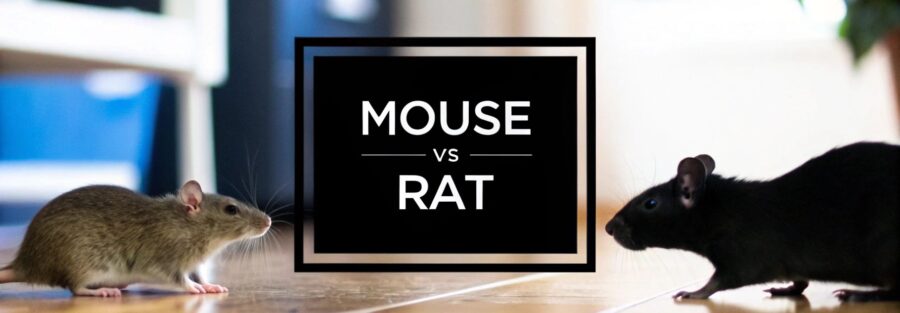When you spot a small, furry creature scurrying across the floor, the immediate question is: mouse or rat? Getting the identification right is the crucial first step, because how you tackle the problem depends entirely on what you’re dealing with.
While they’re both rodents, the common House Mouse (Mus musculus) and the larger Brown Rat (Rattus norvegicus) are worlds apart in terms of size, behaviour, and the threat they pose.
Quickly Identifying a Mouse vs a Rat
At a glance, the most obvious difference is size. But if you only caught a fleeting glimpse, you need to look for other clues. Their habits and the evidence they leave behind are often the biggest giveaways.
Rats, for instance, are naturally cautious and suspicious of new things in their environment. Mice, on the other hand, are curious and far more likely to investigate a freshly laid trap. These behavioural traits are exactly why a one-size-fits-all approach to rodent control just doesn’t work.
This image breaks down the core physical differences at a glance.

As you can see, rats aren't just a bit bigger—they can be more than 10 times heavier than a typical house mouse, which has a massive impact on the control methods needed.
At a Glance Key Differences Between a Mouse and a Rat
If you manage to get a good look, focus on the head, ears, and tail. These features offer the clearest visual clues to tell you what's invaded your space.
A mouse has a small, almost triangular head with surprisingly large, floppy ears and a long, thin tail. In contrast, a rat has a blunt, thickset head with small ears that are almost lost on its bulky frame, finished off with a thick, scaly tail.
A handy rule of thumb: If the rodent's body is longer than its tail, it's almost certainly a rat. If the tail is as long as (or even longer than) its body, you're probably looking at a mouse.
For a quick reference, this table breaks down the key distinguishing features.
| Feature | House Mouse (Mus musculus) | Brown Rat (Rattus norvegicus) |
|---|---|---|
| Body Size | Small, typically 6-10 cm long (excluding tail) | Large, typically 18-25 cm long (excluding tail) |
| Weight | Approximately 15-30 grams | Approximately 200-500 grams |
| Tail | Thin, slightly hairy, and as long as its body | Thick, scaly, and shorter than its body |
| Droppings | Small (3-6 mm), pointed ends, scattered randomly | Large (12-18 mm), capsule-shaped, found in clusters |
| Dietary Preference | Prefers cereals, seeds, and grains | Omnivorous; loves high-protein foods like meat and fish |
| Common Locations | Indoors: Lofts, wall cavities, behind appliances | Outdoors: Burrows, sewers; Indoors: Basements, crawlspaces |
Understanding these differences is more than just academic. It directly influences where you’ll look for them, what bait you’ll use, and what kind of traps will be effective.
Comparing Physical and Anatomical Features
While size is the most immediate giveaway, a closer look at a rodent’s anatomy reveals the definitive clues you need for accurate identification. The difference between mouse and rat features goes far beyond simple scale; their head shape, ears, tail, and even the evidence they leave behind are all distinctly different. Getting these details right is essential for confirming which pest you’re dealing with.

A mouse’s head is small and triangular, ending in a pointed, almost delicate snout. In contrast, a rat has a much blunter, more rounded nose and a chunkier, heavier head. This is a key part of figuring out what is the difference between mouse and rat identification, as these features reflect their very different lifestyles and capabilities.
Head and Facial Features
Another critical differentiator is the size of their ears and eyes relative to their head. Mice have large, floppy ears that look almost oversized for their small frame, along with prominent, dark eyes. Rats, on the other hand, have smaller ears that sit flatter against their head, appearing more proportional to their bulkier build.
These anatomical traits aren't random; they're adaptations. The larger ears of a mouse, for instance, are brilliant for detecting the subtle sounds of predators in quiet indoor spaces.
Tails and Droppings: The Unmistakable Signs
Often, the most reliable evidence you'll find isn't the rodent itself but what it leaves behind. The tail is a primary identifier if you get a clear view.
- Mouse Tail: A mouse's tail is long, thin, and covered in fine hairs. It's often as long as, or even longer than, its body.
- Rat Tail: A rat's tail is thick, scaly, and hairless. It is noticeably shorter than its body length.
Equally important are their droppings, which provide a clear-cut sign of which pest is present. Mouse droppings are tiny, around 3-6 mm, with pointed ends, and often scattered randomly as they travel. Rat droppings are significantly larger, measuring 12-18 mm. They are capsule-shaped with blunt ends and typically found in concentrated piles.
Key Insight: The size and shape of rodent droppings are one of the most conclusive pieces of evidence for identification. Small, rice-sized, pointed droppings mean mice; larger, capsule-shaped droppings mean rats.
These physical distinctions are crucial because they tie directly to the scale of the problem. For instance, the UK's estimated rat population of around 10 million is dominated by the larger brown rat (Rattus norvegicus). This species, which can reach 28-40 cm in body length, is capable of causing significant structural damage due to its size and strength. They prefer infesting larger spaces like sewers and industrial areas, a stark contrast to the smaller house mouse's preference for domestic interiors.
Understanding Their Behavioural Differences
To get a handle on a rodent problem, you first have to understand how your target thinks and acts. The behavioural gap between mice and rats is vast, and knowing this difference is the key to successful control. It dictates everything from where they’ll nest and what they’ll eat, to how they react to threats like traps.
Perhaps the most telling distinction is their reaction to new things. Mice are naturally curious creatures. When they come across something new in their territory, like a bait station or a trap, their first instinct is often to go and investigate it straight away. This inquisitiveness makes them far easier to catch with newly placed traps.
Rats, on the other hand, are a different story altogether. They operate on a principle known as neophobia—a deep-seated fear of anything new. A rat will actively avoid unfamiliar objects in its path, sometimes for days or even weeks. This extreme caution means a trap placed in a rat run will likely be ignored until the rat finally decides it's safe, making them significantly harder to deal with.

Nesting Habits and Social Structures
Their nesting preferences also tell you a lot. Mice are brilliant at exploring indoors, building small, hidden nests very close to their food sources. You’ll often find them tucked away in wall cavities, behind kitchen appliances, or deep within lofts. To get ahead of them, it helps to understand how do mice get in your house so you can adapt your proofing.
Rats, especially the common Brown Rat, are skilled burrowers. They prefer to create extensive tunnel systems outdoors—under decking, in compost heaps, or along the foundations of your house. While they'll certainly venture inside for food, their main base of operations is usually outside the home itself.
Their social lives are also quite different. A mouse infestation usually involves several small, territorial family groups nesting near each other. Rats are more communal, living in larger, more organised colonies with a clear social hierarchy.
Key Takeaway: A mouse's curiosity makes it investigate new traps quickly, while a rat's neophobia means it will avoid them for an extended period. This single behavioural difference is critical for choosing the right control strategy.
Dietary Preferences and Feeding Patterns
Knowing what they like to eat is crucial for effective baiting. Although both are omnivores, their preferences differ quite a bit, which impacts what they’re drawn to.
- Mice: Primarily seed and grain eaters. They are classic nibblers, eating tiny amounts of food from many different spots throughout the night.
- Rats: Prefer high-protein foods. They will eat almost anything but are particularly drawn to meat, fish, and pet food. A rat will typically eat a large meal from just one or two locations.
This contrast in feeding behaviour explains why lots of small bait points work best for mice, whereas fewer, larger bait stations are more suitable for rats. Once you understand the difference between mouse and rat behaviours, you can stop fighting their instincts and start using them to your advantage.
Where They Live and Why It Matters
Understanding where mice and rats choose to set up camp is a critical piece of the pest control puzzle. It’s not just about finding where they are now; it’s about anticipating their next move and sealing off their entry points for good. In fact, the location of an infestation is often the biggest clue to identifying which rodent you’re dealing with.
Mice are the undisputed masters of indoor living. Thanks to their small, agile bodies, they can thrive in the hidden corners of a home. They are fantastic climbers and explorers, often nesting in lofts, wall cavities, and behind kitchen appliances where it's warm and close to a steady food supply.
Rats, on the other hand—especially the common Brown Rat we see across the UK—are fundamentally outdoor creatures. They are powerful burrowers, creating extensive tunnel systems in gardens, under decking, or deep within sewer systems. While they’ll definitely venture inside for food, their main base of operations is usually outside the building itself.
Indoor Specialists Versus Outdoor Opportunists
This difference in nesting habits isn't just an observation; it’s backed by solid UK data. One survey of English homes found that the prevalence of mice inside dwellings was consistently between 1.7% and 2.65%. Rats inside homes were far rarer, found in only 0.28% to 0.46% of properties.
However, that same study found rats outside near buildings were much more common, with a presence of 2.09% to 3.92%. You can learn more about these UK rodent prevalence findings, which highlight just how much mice dominate our indoor spaces while rats patrol the exteriors.
This is exactly why you're far more likely to have a mouse problem in your attic but a rat issue under the garden shed. Mice are adapted to exploit the tiny, hidden spaces within our homes, whereas rats use the outdoors as a staging ground for raids on our kitchens and bins.
Key Insight: If you hear light scurrying noises in your walls or loft, it's almost certainly mice. If you find burrows in the garden or hear heavier, gnawing sounds from under the floorboards, you should suspect rats.
Seasonal Patterns and Nesting Choices
Even the changing seasons affect them differently. The same UK research noted that mouse activity inside homes tends to dip slightly during summer when outdoor food is easier to find. Rat presence indoors, however, showed no real seasonal pattern, reinforcing their status as opportunists who only come inside when it suits them, regardless of the time of year.
This crucial difference in where they live dictates your entire proofing strategy. Sealing a tiny crack to stop a mouse is a completely different job from fortifying your property against the brute force of a rat trying to get in from its burrow next to your foundations.
Comparing Health Risks and Potential Damage
While you definitely don't want either of them in your house, the specific threats that mice and rats bring to the table aren't the same. Understanding the difference helps you grasp the real risk to your health and property, and it underlines why you need to act fast. Both can carry nasty diseases, but how they spread them is a key distinction.
Mice are notorious for spreading bacteria like Salmonella through their droppings. As they scurry around, they leave a constant trail of tiny, contaminated pellets. A single mouse can produce up to 80 droppings in a day, which means kitchen worktops, cupboards, and food preparation areas can get contaminated frighteningly quickly.
Rats, on the other hand, pose a much more severe threat through their urine. They are well-known vectors for Leptospirosis (also known as Weil's disease), a serious bacterial infection. It can be transmitted if their urine gets into water sources or comes into contact with open cuts on your skin.
Structural Damage and Physical Threats
When it comes to property damage, the two are in completely different leagues. A mouse's constant gnawing is certainly destructive over time, but what a rat can do is on another level entirely.
With powerful jaws and teeth that never stop growing, rats can chew through an astonishing range of materials. Their gnawing isn't just a nuisance; it can cause serious structural problems and genuine safety hazards:
- Wood and Plasterboard: Rats will have no trouble creating large holes in walls, floors, and even structural beams.
- Plastic Pipes: Gnawed-through water pipes can lead to leaks, flooding, and significant water damage.
- Electrical Wiring: This is a major one. Chewed cables are a huge fire risk, causing short circuits that can start a blaze inside wall cavities.
- Soft Metals: They’ve even been known to chew through materials like lead and aluminium.
The scale of rodent problems in the UK is staggering. Recent data shows that UK councils conducted 291,132 visits for pest infestations in just one year, and 91% of those involved rodents like rats and mice. That works out to a pest control callout every two minutes nationwide, highlighting the constant battle homeowners are facing. Discover more insights from this UK pest control report.
Assessing the Overall Risk
Because rats are bigger and more aggressive, they also present a more direct physical threat. While it’s rare, a rat bite is a genuine concern and can transmit diseases directly. Their sheer destructive capability also means repairs are usually far more extensive and costly. Dealing with the aftermath of a rat infestation can get expensive; you can learn more about the pest control cost for rats in our detailed guide.
To sum it up, a mouse problem is a serious hygiene issue that needs immediate attention. But a rat infestation brings a much higher level of risk, combining severe disease transmission with the potential for catastrophic structural damage and fire hazards. Knowing the difference helps you prioritise your response and protect your property and family.
Choosing the Right Pest Control Strategy
Knowing whether you’ve got mice or rats is only half the battle; using the right control strategy is what really counts. Trying to use mouse tactics on a rat problem is a recipe for failure, wasting your time and money. The secret is tailoring your approach to the specific behaviours of the rodent you’re up against.
Mice are naturally curious, a trait you can and should exploit. They'll happily investigate new objects in their path, which is why placing multiple small traps or bait stations along their known routes is so effective. Think small, and think numerous – it perfectly matches their scattered, nibbling feeding habits.
Rats, on the other hand, demand a completely different mindset. Their inbuilt neophobia, or fear of new things, means they'll actively avoid a freshly placed trap for days. Getting past this suspicion is critical if you want to succeed.

Tailoring Your Trapping and Baiting
When you're dealing with a rat infestation, patience is your greatest tool. A common professional technique is pre-baiting, where you place traps in position but leave them unset for several days. By putting bait like peanut butter on the unset trap, you give the rats time to get used to it and see it as a safe source of food.
Only set the trap once you see clear signs they’re comfortable taking the bait. This methodical approach works with their cautious nature, not against it.
A key mistake we see is people placing a single, large rat trap and expecting immediate results. A successful strategy involves overcoming the rat's natural suspicion over time, which often means letting them get away with the bait at first to build their confidence.
Proofing Your Property Correctly
Exclusion, or "proofing," is another area where the differences between mouse and rat control become crystal clear. The materials and effort needed are worlds apart, purely down to their size and strength.
To block access for good, you need to think about these points:
- For Mice: A mouse can squeeze through a hole the size of a pencil's diameter (around 6-7 mm). Sealing small gaps with wire wool and decorators caulk is often all you need to keep them out of interior spaces.
- For Rats: A rat can chew straight through wood, plastic, and even soft metals like aluminium. Proofing against them requires much tougher materials. Use galvanised steel mesh, cement, or metal plating to cover any potential entry points, paying close attention to foundations and drains.
At the end of the day, a mouse problem is often an internal affair that needs meticulous sealing of tiny gaps. A rat problem, however, usually starts outside and demands heavy-duty fortification to stop them from breaching your property. Understanding this fundamental difference ensures your efforts are effective and will actually last.
Common Questions About Mice and Rats
When you suspect a rodent problem, questions pop up fast. Getting the right answers is the first step to getting rid of them for good. Here’s what our experts are asked most often.
Can You Have Both Rats and Mice at the Same Time?
It’s incredibly unlikely you'll find both species setting up camp together. Rats are bigger, stronger, and far more aggressive—they see mice as competition for food and will hunt and kill them on sight.
If you are seeing signs of both, it usually means one of two things: a rat population has just moved in and driven the mice out, or you have a very large property where they’ve managed to claim entirely separate territories, well away from each other.
What Do Scratching Noises in Walls Mean?
Those scratching and scuttling sounds are a dead giveaway for rodents. But if you listen closely, the noise itself can tell you who you’re dealing with.
- Light, fast-paced scurrying often heard at night is classic mouse behaviour. They're quick and nimble, easily exploring wall cavities and loft spaces.
- Heavier, slower gnawing or dragging sounds point straight to rats. You’ll often hear this from under the floorboards, in cellars, or deep within the walls.
When Should I Call a Professional Pest Controller?
It's time to call in the professionals the moment you're not 100% sure what you're dealing with, if the problem seems to be growing, or if your own attempts with shop-bought traps haven't worked.
Rats, especially, are a case for immediate expert help. They are notoriously shy of new things (like traps) and carry serious diseases, such as Leptospirosis (Weil's disease).
A certified pest controller won’t just put down bait; they’ll identify the species, find the source of the infestation, and use professional-grade treatments safely and legally. This is the only way to get a lasting solution, not just a temporary pause in activity.
Dealing with a stubborn rodent problem requires specialist knowledge. Pest Predators Limited offers science-led, effective solutions to identify and eliminate infestations for good. Protect your property by scheduling a consultation today.



